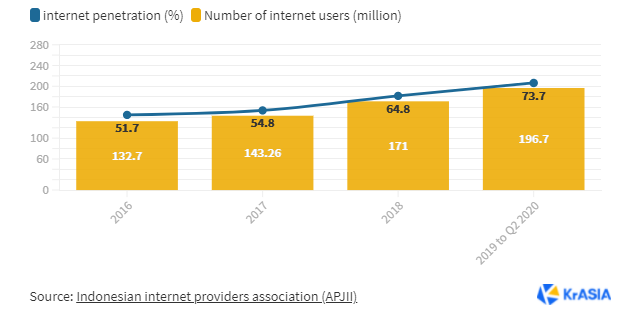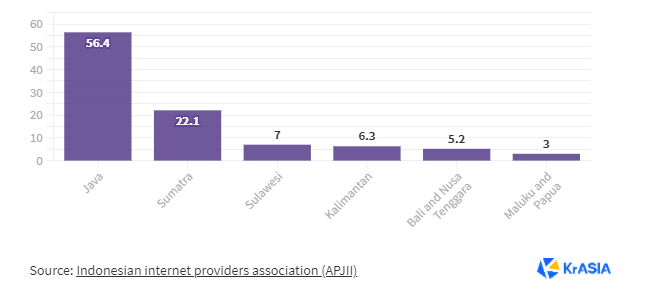With Millions of People Starting to Access the Internet Every Year, Monumental Changes Will Happen in Indonesia's Rural Areas
Services built for urbanites may not suit the needs of people living in smaller cities, while new hyperlocal services are being created.
Jakarta is a city full of juxtaposition. Alongside the many mosques there is a lively nightlife, although many neighborhoods also close after dark. More than half a decade ago, if you wanted a late-night snack, the options were limited—get creative in your own kitchen or wait until daybreak. However, all of that has changed. Now, you can get your food delivered right to the front pintu home almost any time with just a few taps on the phone. Smartphones and stable internet connections have changed our expectations and the way we spend our money. urbanites, in particular, are pampered with comfort.
A similar transformation is taking place in less densely populated areas of the country. With the pandemic not over yet and the continued development of new infrastructure, this development is only happening rapidly in developing countries. About 40 million people in six countries in Southeast Asia—Singapore, Malaysia, Indonesia, the Philippines, Vietnam and Thailand—go online for the first time in 2020, according to report Google, Temasek Holdings, and Bain & Company. This is much higher than 2018's figure of 10 million, or a total of 100 million between 2015 and 2019. The seven metropolitan areas, including Jakarta, account for more than 50% of the region's internet economy, but areas outside the major cities have potential. to grow twice as fast, say the report authors.
With all these new developments, Southeast Asian society will be more connected than ever. What are the hopes of newcomers in cyberspace?
Social media dominates
In 2019, Amalia, who worked in a government agency, was transferred to Indonesia's easternmost province, Papua. Born and raised in Jakarta, his move required a lot of adjustments. “The internet connection is pretty stable during the day, but often drops suddenly at night,” he told KrASIA.
In Q2 2020, the number of internet users in Indonesia reached 196,7 million or 73,7% of the population. The country saw 25,5 million people online for the first time in the span of 2019 to 2020, according to a report by the Indonesian internet providers association.
Number of internet users in Indonesia
New internet users in Java reached 56,4%, followed by Sumatra (22,1%), Sulawesi Island (7%), Kalimantan (6,3%), Bali and Nusa Tenggara (5,2%), and Maluku -Papua (3%), mentioned in the report.
As is common in developing countries, many Indonesians have gone through personal computers and access the internet mainly through their smartphones. The main motivation is to access social media, messaging applications, and informational and recreational content.
Internet penetration (%) in Indonesia from 2019 to Q2 2020
“There are several public hotspots available in urban areas. Lots of people "hanging out" around hotspots for free internet. Most of them use the internet for entertainment, such as streaming music, and to access social media platforms. People are also starting to use online learning tools a lot during the pandemic,” said Amalia.
In line with Amalia's observation, East Ventures' operating partner, David Fernando Audy said that the needs of novice internet users are certainly different from the needs of people who tech-savvy in the metro area. Typically, they seek access to new information, absorbing text and images through queries in search engines before joining social media networks.
“Once they have sufficient internet speed to search and share images, they will become active users of social media platforms like Facebook or Instagram. They also want to consume audio-visual content from platforms like YouTube. After getting used to using the internet and social media, they will start exploring online commerce, which is a more advanced service,” said Audy.
However, digital service providers tend to design and manufacture products based on the needs of urban communities because they are often the first users with higher disposable income, and the market is much denser and larger. For example, it's easy to find information about restaurants in Jakarta, and there is a large list of events, all of which can be searched on food delivery apps or event tickets. However, just one step away from the metro area, the situation will be much different.
"We have Gojek and Grab here, but they are not always available like in Jakarta,” said Amalia. “To stay up-to-date, we usually follow local community accounts like Info Jayapura on Facebook and Instagram—these are two must-have apps here.”
Outside of big cities, even though they are familiar with online shopping, they still prefer to use Facebook than Tokopedia or Shopee. "Based on my experience and observations, people like to buy things online through Facebook Marketplace because they have a lot of local options, and it's easier to contact sellers there," added Amelia. Broadly speaking, social media is a pintu the first gateway for micro, small and medium enterprises (MSMEs) in running their business online. They started with Facebook and WhatsApp and eventually turned to e-commerce platforms to expand their market reach.
Specific services for new internet users
The most competitive arenas—which are almost non-existent in urban cities—will be services hyperlocal built for lower-level cities. This can manifest in group purchases and social commerce, where community networks move people's shopping habits online, often with locals acting as group leaders or representatives. The human touch in this setting removes the doubts some may have about making online transactions.
Investors have poured checks for service providers hyperlocal in anticipation of soaring business growth. Super social trading provider recently collected USD 28 million in a Series B round led by SoftBank, and KitaBeli raised USD 10 million from AC Ventures and East Ventures in April. Both platforms sell fast-moving consumer goods in areas outside Indonesia's major cities and often cater to people who have never shopped online before. Elsewhere in the region, social commerce is still a new sector, with new platforms emerging in recent years, such as Webuy in Singapore and Mio in Vietnam, which raised seed funding in May.
In addition to huge consumer tastes, the digitization of small businesses will also reshape Indonesia's commercial landscape. Through reports digital competitiveness reportAccording to him, East Ventures projects that all regions in the country will be connected to the internet next year, and 18,4 million MSMEs will be connected to the internet go digital at the end of 2022.
Several startups have made it happen. Bookkeeping startups like BookStore and Cash book is also on the rise. They managed to secure major funding recently, and both claim to have digitized millions of MSMEs in small towns across the country. Meanwhile, Tokopedia Partners, Bukalapak Partners, GrabKiosk by Kudo, Warung Pintar, and Ula has developed a platform for shop owners to digitally manage their inventory and orders. So far, many of these services have been limited to Java, but Audy from East Ventures believes their footprint can spread as MSMEs are passed on to young people who mobile-first.
“Small businesses such as neighboring warungs and restaurants are usually owned by families, and now there has been a regeneration where millennials manage these kiosks, and they are more open to using digital services,” said Audy. “More and more MSMEs are willing to sell online, but often have difficulty managing several online stores simultaneously, especially because most micro and small businesses do not have employees. Therefore, there will be more requests for e-commerce enablers. For example, there is Sirclo, which allows small business owners to easily open and manage multiple online stores.”
The importance of technology in remote areas
There are multiple consequences of the rapid acceleration of digital transformation during the pandemic —better access to education and stronger engagement in the wider community beyond their immediate environment. However, while this population now has access to new channels for information exchange, they still need higher internet speeds, stable connections, and local services.
In a speech given last year, Indonesian President Joko Widodo said the pandemic was a catalyst for rural economic transformation. He promised the government would provide more access to technology, capital and capacity building. One of the public's efforts is the construction of the Palapa Ring fiber optic cable network, especially in eastern Indonesia.
The pandemic has forced businesses and public organizations to put their employees to work from home. The multitude of productivity and collaboration tools available, coupled with high-speed internet, makes this possible. Many people who live and work in urban areas return to their hometowns to save on rent and living expenses. If this arrangement continues after the pandemic, urbanization may slow down, and people living in smaller cities will be able to work remotely for businesses anywhere in the country. This opens up new opportunities for people in tier-2 and tier-3 cities and could even change the way corporate offices and headquarters will operate in the near future.
-This article was first released by KRASIA. Re-released in Indonesian as part of the collaboration with DailySocial
Sign up for our
newsletter


